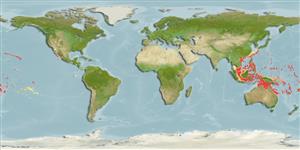>
Acanthuriformes (Surgeonfishes) >
Pomacanthidae (Angelfishes)
Etymology: Centropyge: Greek, kentron = sting + Greek, pyge = tail (Ref. 45335).
Eponymy: Dr Earl Stannard Herald (1914–1973) was an American ichthyologist. [...] (Ref. 128868), visit book page.
More on authors: Woods & Schultz.
Environment: milieu / climate zone / depth range / distribution range
Ökologie
seewasser riff-verbunden; standorttreu; tiefenbereich 5 - 90 m (Ref. 33482). Tropical; 32°N - 24°S
Indo-Pacific Ocean: from Sri lanka and Bali to the Indo-Malay archipelago to the Marshall Islands.
Size / Gewicht / Alter
Maturity: Lm ? range ? - ? cm
Max length : 12.0 cm TL Männchen/unbestimmt; (Ref. 89972)
Rückenflossenstacheln (insgesamt) : 15; Rückenflossenweichstrahlen (insgesamt) : 15; Afterflossenstacheln: 3; Afterflossenweichstrahlen: 17. Overall color is bright yellow to bright yellow orange with a dusky olive patch with yellow spots behind the eye.
Inhabits steep outer reef slopes, occasionally on lagoon reefs (Ref. 9710). Herbivorous (Ref. 33482). Forms harems of 2-4 individuals. Frequently exported through the aquarium trade (Ref. 48391).
Life cycle and mating behavior
Geschlechtsreife | Fortpflanzung | Ablaichen | Eier | Fecundity | Larven
Myers, R.F., 1991. Micronesian reef fishes. Second Ed. Coral Graphics, Barrigada, Guam. 298 p. (Ref. 1602)
IUCN Rote Liste Status (Ref. 130435: Version 2024-2)
Bedrohung für Menschen
Harmless
Nutzung durch Menschen
Fischereien: kommerziell; Aquarium: Kommerziell
Tools
Zusatzinformationen
Download XML
Internet Quellen
Estimates based on models
Preferred temperature (Ref.
123201): 25 - 28.9, mean 27.6 °C (based on 334 cells).
Phylogenetic diversity index (Ref.
82804): PD
50 = 0.5000 [Uniqueness, from 0.5 = low to 2.0 = high].
Bayesian length-weight: a=0.03090 (0.01378 - 0.06932), b=2.88 (2.69 - 3.07), in cm total length, based on LWR estimates for this (Sub)family-body shape (Ref.
93245).
Trophic level (Ref.
69278): 2.8 ±0.33 se; based on food items.
Widerstandsfähigkeit (Ref.
120179): hoch, Verdopplung der Population dauert weniger als 15 Monate. (Preliminary K or Fecundity.).
Fishing Vulnerability (Ref.
59153): Low vulnerability (10 of 100).
Nutrients (Ref.
124155): Calcium = 91.3 [44.6, 139.7] mg/100g; Iron = 0.68 [0.42, 1.12] mg/100g; Protein = 18.1 [16.9, 19.3] %; Omega3 = 0.126 [0.076, 0.203] g/100g; Selenium = 29.3 [16.0, 53.7] μg/100g; VitaminA = 95.5 [26.2, 339.6] μg/100g; Zinc = 1.61 [1.11, 2.32] mg/100g (wet weight);
